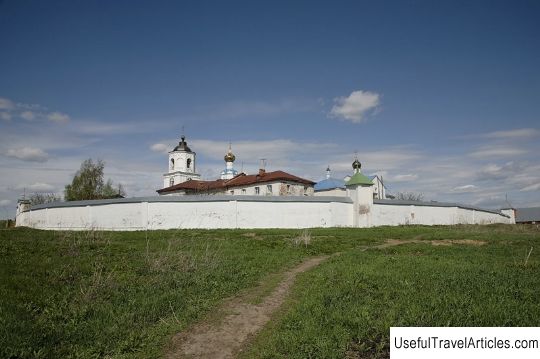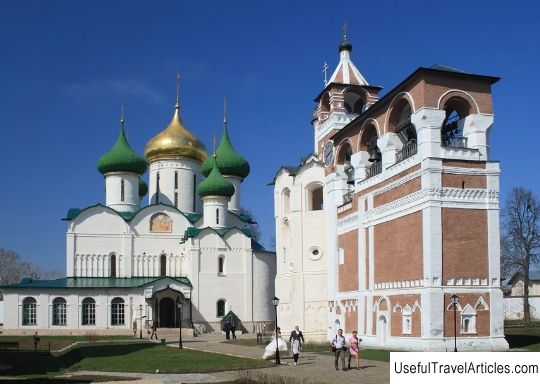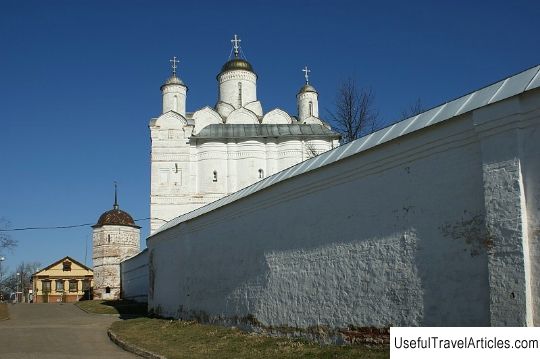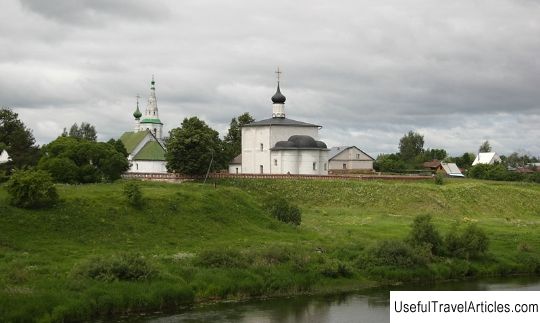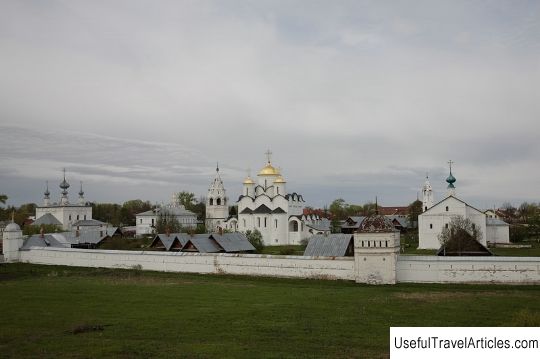Suzdal Kremlin description and photos - Russia - Golden Ring: Suzdal
Rating: 7,8/10 (1789 votes) 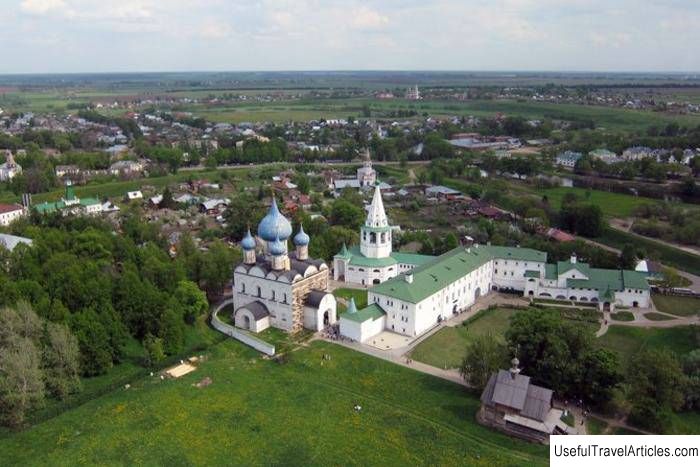
Suzdal Kremlin description and photos - Russia - Golden Ring: Suzdal. Detailed information about the attraction. Description, photos and a map showing the nearest significant objects. Photo and descriptionThe picturesque ensemble of the Suzdal Kremlin includes ancient earthen ramparts, on which a wooden fortress was once located, the Cathedral of the Nativity of the Virgin of the 13th-15th centuries, a complex of bishops' chambers with the Annunciation Church, bell tower and courtyard of the 17th-18th centuries and the wooden Nikolskaya Church of the 18th century brought here from the village of Glotova. Bishops' chambers are occupied with museum expositions. Suzdal FortressA settlement on the site of present-day Suzdal has existed since the 11th century. Then the first fortress appeared here - earthen ramparts and wooden fortifications on them. The first mention in the chronicle dates back to 1054, when the local pagan population rose up in protest against baptism. The fortress remained wooden throughout the entire history of the city. Suzdal's status is changing, it is part of different principalities, until in 1392 it is included in the Grand Duchy of Moscow. The fortifications burned and collapsed many times. In 1445, a big battle took place here, during which the Moscow prince Vasily II was taken prisoner by the Tatar, and the city was burned. After that, the walls are renewed and rebuilt. The ramparts grow higher and the city is surrounded by a new wooden wall with fifteen high towers. This fortress successfully withstands hostilities during the Time of Troubles. Suzdal supported Vasily Shuisky and defended against Moscow for a long time in 1608-1610, and then in 1612 withstood the Polish siege. After that, the fortress is renovated, but in the future the stake is more likely on the ring of stone fortresses-monasteries surrounding the city. In the 17th-18th centuries, no military actions were carried out in the central regions, the Kremlin was slowly decaying. In 1719, after another fire, it was finally dismantled. High ramparts and a cathedral complex have survived to this day. Cathedral of the Nativity of the Virgin The temple at this place has existed since the XII century. Scientists argue about the exact year in which it was built and how many times it was ravaged and rebuilt. The foundation and the lower part of the current building have been preserved since 1222 - then, by order of the Vladimir prince Yuri Vsevolodovich, a new church with three heads was built, on the site of an old one, about which we know little. The cathedral was repeatedly burned, destroyed, renovated, and in the end, in 1528, its entire upper part was dismantled and replaced with a new, five-domed one, and the paintings were re-executed. From the old cathedral there are several fragments of 13th century frescoes on the lower part of the walls and a white stone carved lower belt of the cathedral with faces and animal masks, similar in style to the carvings of Vladimir churches. The gilded western and southern gates of the temple are unique. This gate is made of oak and covered with copper plates with gilded images on them. This technique is called "fire gilding" and is sometimes still used today. The famous "Golden Gate" of Vladimir was made in the same way, but their doors have not survived, and in Suzdal you can see two such gates, decorated with gilded icons. Some of them are completely devoted to images associated with the Archangel Michael, others contain festive icons of Christ and the Mother of God. The royal doors of the cathedral were made in the 17th century, and the five-tiered iconostasis - in the 17th century. The cathedral served as the burial vault of Suzdal princes and bishops. Here are buried the children of Yuri Dolgoruky, the holy bishops Theodore and John - the first bishops of Suzdal. Here was buried St. Arseny of Elassonsky is a Greek by birth, who became the Moscow archbishop during the Time of Troubles and took part in all the events that took place then. It was he who married Mikhail Romanov to the kingdom in 1613. He was canonized in 1982, but now his relics are not here, but in the Assumption Cathedral, but the burial place is marked. The most famous Suzdal bishop, Illarion, who died in 1708, is buried here. He was not officially canonized, but he began to be worshiped by the Suzdal people almost immediately after his death. Since 1923, the building of the cathedral was transferred to the museum. Divine services continued for some time in the Annunciation Limit, but soon it was closed too. In the XX century, the cathedral was restored twice - in 1954-1964 under the leadership of the architect-restorer A.D. Varganov, and in the 2010s under the leadership of the modern Vladimir architect V. Anisimov. These reconstructions returned it to its original appearance after all the layers and changes of the 18th century. Since 1992, the temple has been included in the UNESCO World Heritage List. From the same year it was returned to the church and is now used in conjunction with the Vladimir-Suzdal Museum-Reserve. Complex of Bishops' Chambers Suzdal was the seat of bishops. The wooden bishop's palace has not survived, but the bishops' chambers have survived. They were built from bricks in the 15th century. The Annunciation Church and the octahedral bell tower adjoined them. The bell tower was decorated with a chime clock, which has survived to our time. This movement was created by Suzdal craftsmen. It was repaired and refurbished several times, but the basis of the mechanism is still in working order - the clock is running. The whole complex received its final form at the turn of the 17th-18th centuries under Metropolitan Hilarion: an altar was added to the bell tower, it was connected to the bishops' boards by galleries, and as a result the whole complex formed a closed courtyard. The center was a huge cross chamber, made without supporting pillars, with nine-meter ceilings and a total area of more than three hundred square meters. meters. This is a ceremonial hall, intended for official ceremonies, the announcement of royal and episcopal decrees, and solemn bishop's dinners. Now the interior of the 17th century has been reproduced here. The Bishops' Chambers were transferred to the museum in 1922, and in 1923 the first exposition was opened here. The first director was V. Romanovsky, a historian and teacher who devoted himself to preserving the historical heritage of the Suzdal region, which after the revolution was ruined. Many valuables were brought here from the closing temples and monasteries, which were thus saved from confiscation and destruction. Now there are several museum expositions. The main one, dating back to the 1970s, is The History of the Suzdal Land. It occupies nine rooms and was recently redesigned by modern designers. The exposition tells not only about Suzdal itself, but about those monasteries that were in its vicinity. The last room is dedicated to today's Suzdal and the problem of preserving historical buildings and architectural monuments. The Annunciation Church now houses an exposition dedicated to icon painting. Here are collected more than fifty icons from the 15th century, collected from the churches of the Vladimir-Suzdal region. Most of them were created by local painters, but there are icons from Novgorod, Rostov and Moscow that belong to other icon-painting schools. An exhibition of one exhibit, the 17th century Jordan canopy, is taking place in the bell tower. This is a wooden canopy which was made by order of Metropolitan Hilarion and was located above his throne. Its height is 8.5 meters and it is made of 260 wooden parts. It was kept in a disassembled state and was assembled only a few times a year on the biggest holidays. The exposition is interactive and is accompanied by computer images of the canopy and all its details. Another unique exhibit of the Suzdal museum is a huge handwritten Gospel in a silver setting, which is now called the Tsar Book. The engraving of the setting was created in the 17th century by the famous engraver Afanasy Tukhmensky. It is the largest handwritten book in Russia, and the second largest book in Europe, weighing over 35 kilograms and richly decorated with miniatures. Tradition says that it was a gift to the Nativity Cathedral from Princess Sophia. In addition, there is a children's museum center in the bishops' chambers. This is a colorful interactive exhibition that tells about the old Suzdal of the early XX century. Here are held children's master classes, classes and holidays. St. Nicholas Church from the village of GlotovoA unique monument was transported to the territory of the Suzdal Kremlin - the wooden St. Nicholas Church from the village of Glotovo. The village church was built in 1766, and in 1960 it was moved to the city in order to preserve the historical heritage and develop tourism. The assembly and disassembly was supervised by the restorer A. Varganov. In 2008, the church was restored and some of the decayed logs of its log cabins were replaced. The church was cut down with axes and one cannot say that "without a single nail" - using wooden nails. This type of church is called "cage", it is made of two interconnecting rooms - "cages" - and is surrounded by a wooden gallery. This church was warm and was used for worship during the winter. The cold stone church in the village of Glotovo has only partially survived to this day. Interesting factsThe water bowl of the Cathedral of the Nativity of the Virgin was made in the 19th century and looks like a huge samovar. The 1964 film "Blizzard" was filmed in the wooden church of Glotov - this is where the wedding of the main character takes place. Notes
        We also recommend reading Pantelleria island description and photos - Italy: Sicily island Topic: Suzdal Kremlin description and photos - Russia - Golden Ring: Suzdal. |
